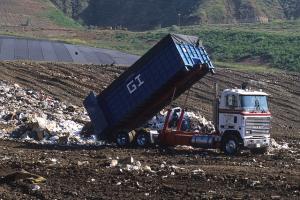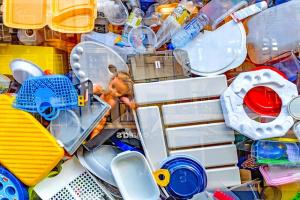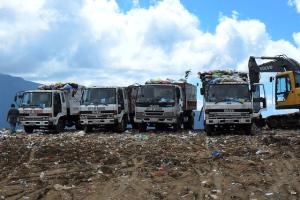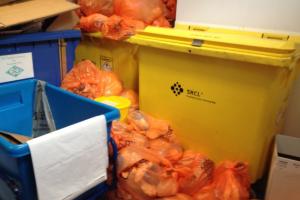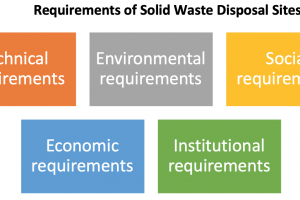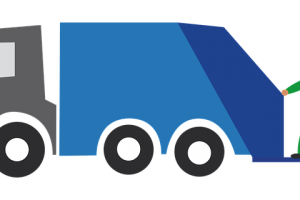Functional Elements of Solid Waste Management System
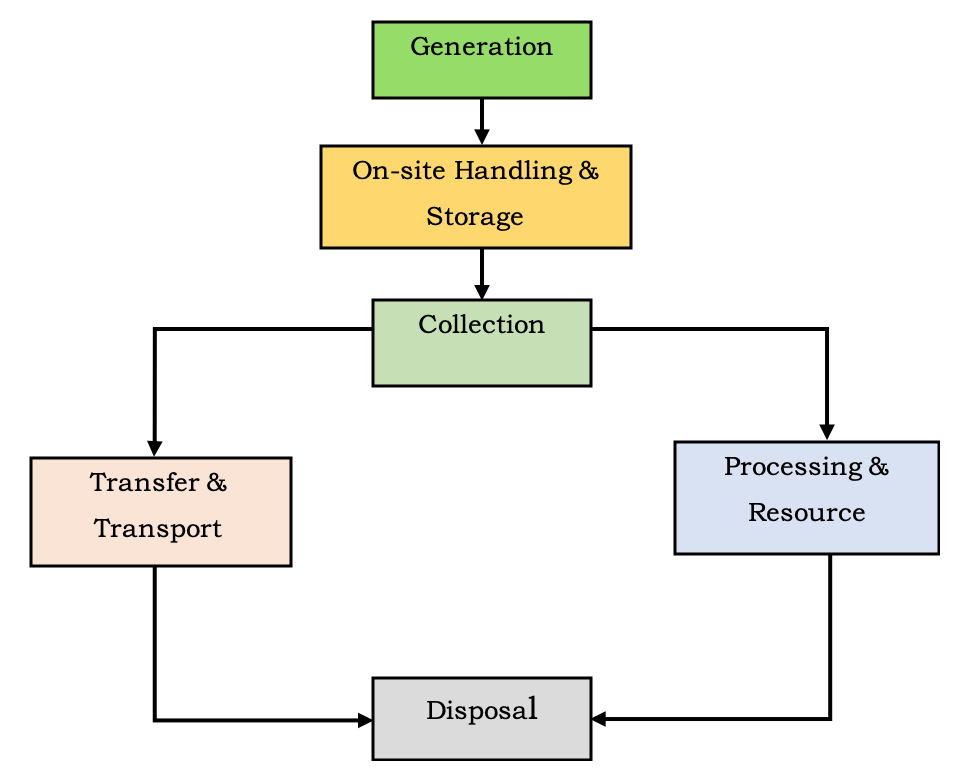
Functional Elements of Solid Waste Management System comprises of six basic elements including:
- Generation of the solid waste
- On-site handling & storage
- Collection
- Transfer & transport
- Material and resource recovery and
- Disposal
Generation of Solid Waste
Solid waste generation refers to the creation of waste materials by residential, commercial, and industrial activities. This function involves understanding the sources, quantities, and composition of waste to develop appropriate waste management strategies. Waste generation rates can be estimated using the following equation:
Waste Generation = Population × Per Capita Waste Generation Rate
For example, if a city has a population of 100,000 and the per capita waste generation rate is 1.2 kg/person/day, the estimated waste generation would be 120,000 kg/day.
The generation of solid waste is a result of natural, human, and animal activities. Knowledge of the generation of solid waste is important in the planning, designing, and operation of solid waste management systems. Generation has two aspects: One is the quality of solid waste and the other is the quantity of solid waste. Quality includes the sources, types, and typical composition of solid waste along with its properties whereas the quantity represents the generation rates and total quantities and volumes of waste generated.
The handling, storage, and separation of solid waste at the source before they are collected is a critical step in the management of residential solid waste.
Waste Handling
Handling refers to activities associated with managing solid wastes until they are placed in the containers used for their storage before collection or return to drop-off and recycling centers. The specific activities associated with handling waste materials at the source of generation will vary depending on the types of waste materials that are separated for reuse and recycling and the extent to which these materials are separated from the waste stream. Depending on the type of collection service, handling may also be required to move the loaded containers to the collection point and to return the empty container to the point where they are stored between collections.
On-site handling and storage involve the proper containment and temporary storage of waste at the point of generation. It includes activities such as waste segregation, waste minimization, and the use of appropriate containers or bins. For instance, households may use separate bins for recyclable materials (e.g., paper, plastic, glass) and non-recyclable waste. On-site storage ensures that waste is properly managed until it is collected.
Waste Storage
The first phase to manage solid waste is at the home level. It requires temporary storage of refuse on the premises. The individual household or businessman has responsibility for the onsite storage of solid waste. For individual homes, industries, and other commercial centers, proper on-site storage of solid waste is the beginning of proper disposal, because unkept solid waste or simple dumps are sources of nuisance, flies, smells, and other hazards.
Collection
The term “collection” includes not only the gathering or picking up of solid wastes from various sources but also the hauling of these wastes to the disposal site or transfer station and unloading there. While hauling and unloading are similar for most collection systems, the collection or pickup of waste varies with facilities and locations. The collection is the process of gathering and transporting waste from various sources to a central location or transfer station. Efficient collection systems are designed based on factors such as population density, waste generation rates, and transportation logistics. Collection methods include curbside collection, door-to-door collection, and community drop-off points. Collection vehicles, such as garbage trucks, are used to transport waste to the next stage.
Transfer and Transport
Transfer and Transport refer to the means, facilities, and appurtenances used to affect the transfer of wastes from one location to another, usually a more distant location. Typically, the wastes from relatively small collection vehicles are transferred to larger vehicles and then transported to distant locations.
Transfer and transport involve the movement of waste from the collection points or transfer stations to treatment or disposal facilities. Waste transfer stations act as intermediate hubs where waste is consolidated from smaller collection vehicles into larger transport vehicles. Proper handling, containment, and transport equipment are essential to prevent spillage, littering, and odor nuisances during transfer and transport processes.
Resource Recovery and Processing
Resource recovery is a partial solid waste disposal and reclamation process. It can be expected to achieve waste reductions in future landfill volume requirements. Resource recovery must recognize what is worth recovering and the environmental benefits.
Material and resource recovery focuses on extracting value from waste by recycling, composting, or recovering energy from it. These processes reduce the volume of waste sent to disposal facilities and conserve natural resources. Examples of material and resource recovery include:
- Recycling: Separating and processing recyclable materials such as paper, plastic, metal, and glass for remanufacturing into new products.
- Composting: Decomposing organic waste materials, such as food scraps and yard waste, to produce nutrient-rich compost for soil amendment.
- Energy Recovery: Utilizing waste as a fuel source through processes like waste-to-energy (WTE) or anaerobic digestion to generate electricity or heat.
Disposal
Most of the organic content after segregation may be subjected to bacterial decomposition with an end product called humus or compost. The entire process involving both separation and bacterial conversion is known as “Composting” Decomposition of solid waste may be accomplished aerobically or anaerobically.
Disposal is the final stage of solid waste management when waste that cannot be recovered or recycled is safely and responsibly disposed of. Common disposal methods include landfilling and incineration.
- Landfilling: Waste is placed in a specially engineered landfill, where it undergoes controlled decomposition over time. Landfills are designed with liners, leachate collection systems, and gas management infrastructure to minimize environmental impacts.
- Incineration: Waste is burned at high temperatures in waste-to-energy facilities, reducing its volume and generating electricity or heat. Modern incineration plants are equipped with air pollution control technologies to minimize emissions.



